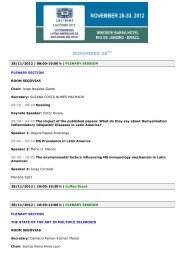Keynote Conference - Interevent
Keynote Conference - Interevent
Keynote Conference - Interevent
Create successful ePaper yourself
Turn your PDF publications into a flip-book with our unique Google optimized e-Paper software.
Symp#11 Glia Club<br />
Chairs Bernardo Castellano and Vivaldo Moura Neto<br />
GSK3β is a Profound Negative Regulator of Oligodendrocyte Differentiation and Myelination<br />
Arthur M. Butt, Andrea Rivera and Kasum Azim<br />
Institute of Biomedical and Biomolecular Sciences, University of Portsmouth, U.K.<br />
Oligodendrocytes are the myelinating cells of the central nervous system and are the primary targets of tissue destruction in the<br />
demyelinating disease multiple sclerosis. The enzyme GSK3β is a target of many receptor-mediated signalling pathways that regulate the<br />
differentiation of from their precursors (OPCs). We have examined this using a range of small molecular inhibitors of GSK3β in the mouse<br />
brain. Inhibition of GSK3β stimulates the generation of OPCs from neural precursor cells (NPCs) in the subventricular zone (SVZ), involving the<br />
canonical Wnt-β-catenin signalling pathway. Significantly, inhibition of GSK3β also dramatically stimulates oligodendrocyte differentiation and<br />
myelination. A key finding is that GSK3β inhibition has equivalent effects in the adult and stimulates the regeneration of oligodendrocytes and<br />
remyelination following demyelination in the adult forebrain. Using a genome wide microarray approach, we find that GSK3β inhibition<br />
regulates oligodendrocyte generation via multiple positive and negative regulatory signalling pathways. GSK3β inhibition significantly upregulated<br />
Sox10 and Olig2, key positive regulators of oligodendrocyte differentiation, and down-regulated the Wnt and Notch signalling<br />
pathways, together with helix-loop-helix ID (inhibitor of differentiation), which are dominant negative regulators of oligodendrocyte<br />
differentiation. This study identifies novel functions for GSK3β as a profound negative regulator of oligodendrocytes at all stages of their<br />
differentiation in vivo. Moreover, our findings indicated that GSK3β signalling pathways contributed to inefficient regeneration of<br />
oligodendrocytes and myelin repair in demyelination.<br />
Role of Cancer Stem Cells in Adult and Paediatric Brain Neoplasms: Hoax or Holy Grail?<br />
Professor Geoffrey J Pilkington BSc PhD CBiol FSB FRCPath<br />
Professor of Cellular and Molecular Neuro-oncology, University of Portsmouth, St Michael’s Building, White Swan Road Portsmouth PO1 2DT<br />
UK<br />
In the 1970s stem cell-like populations were described in ethylnitrosourea-induced rat glioma and hypothesised as the origin of such tumours.<br />
These were located around blood vessels and degenerating neurones, sub-ependymally, at the lateral ventricles. More recently cancer stem<br />
cells (CSCs), reported largely on their expression of CD133, gathered considerable interest in adult and paediatric brain tumours. Initial<br />
observations that the CD133+ population were the initiators of brain tumours, based upon their ability to produce tumours in xenograft<br />
models while CD133- failed to do so have, however, been challenged. The value of CD133 (Prominin-1) has therefore been questioned but the<br />
function of CD133 or its possible link with processes underlying tumour development and progression remains obscure. Adult glioblastoma<br />
biopsies yield only 1-5% CSCs based upon CD133 immunostaining. We described a low passage paediatric glioblastoma culture where over<br />
40% of the cells express CD133 and, if transferred to neural basal medium under hypoxic conditions, this elevated to >95% CD133+. Magnetic<br />
bead immunoseparated CD133+ and CD133- were used for genetic profiling, adhesion, invasion, and proliferation assays in response to<br />
nuclear- and mitochondrially-acting pro-apoptotic agents. We also investigated the significance of CD133 glycosylation and influence of oxygen<br />
on such glycosylation. Whether or not CD133 is a marker of CSCs in brain tumours remains controversial but it may be of significance to the<br />
biology of paediatric brain neoplasms and requires further investigation both in vitro and in tissue sections. Hoax? certainly not, but CD133<br />
must be put into context and, while the Holy Grail issue remains unresolved, this is an area of intense interest in unravelling the mysteries of<br />
tumour biology.<br />
Mesenchymal Stem Cells lower proliferation and invasion of Glioblastoma cells, exploiting the Immune Response Mediating Chemokines<br />
Tamara T. Lah, Motaln H 1 , Gruden K 2 , Hren M 2 , Primon M 1 and Schichor Ch 3<br />
1. Department of Genetic Toxicology and Cancer Biology, National Institute of Biology, Ljubljana, Slovenia. 2 Department of Biotechnology and<br />
Systems Biology, National Institute of Biology, Ljubljana, Slovenia. 3 Klinikum Großhadern, Ludwig-Maximilians-Universität, München,<br />
Germany.<br />
Human mesenchymal stem cells (hMSC) are gaining the forefront position in therapies for curing several diseases. The majority of them is<br />
focused on the improvements in the regenerative medicine, whereas only limited number of studies is addressing the potential use of hMSC<br />
for anti-cancer therapy, although the findings in several different cancer models are suggesting they could be developed into efficient cellbased<br />
therapeutics.<br />
Considering recent in vivo and in vitro reports on hMSCs growth inhibitory effect on most malignant brain tumor – glioblastoma multiforme<br />
(GBM) we focused here on the cellular processes responsible for this inhibitory effect, such as cell proliferation, invasion and senescence<br />
which we confirmed in several GBM lines. We performed whole genome mRNA analysis and cytokine profiling of both, the hMSC and the U87-<br />
MG GBM cells grown in co-cultures. We found that several chemokines may account either for the decrease of both, proliferation and invasion<br />
of U87-MG, as well as for induced MSCs proliferation and invasion when the two cells were grown in the indirect co-cultures. CCL2/MCP-1 was<br />
collectively identified as one of the few most significantly up-regulated chemokine responsible for hMSC and U87-MG paracrine signaling and<br />
we functionally confirmed its role in GBM cell invasion in vitro.<br />
In conclusion, our results indicate the CCL2/MCP1 to be the key player of paracrine MSC/glioma cell interactions. Several other gene/protein<br />
putative markers were identified to take part in hMSC/glioma cell communication for the first time. Together with CCL2/MCP-1 those markers<br />
could be utilized in future, as target genes for cell-based anticancer therapy.<br />
Effects of cns-targeted il-6 or il-10 production on microglial activation and motor neuron degeneration after facial nerve<br />
axotomy<br />
B. Castellano 1, N. Villacampa 1, B. Almolda 1, I.L. Campbell 2 and B. González 1<br />
1Department of Cell Biology, Physiology and Immunology, Institute of Neurosciences. Universitat Autònoma de Barcelona, Spain. 2School of<br />
Molecular Bioscience, University of Sydney, Sydney, NSW 2006, Australia<br />
Interleukin-6 (IL-6) and Interleukin-10 (IL-10) are key cytokines with an important role in the regulation of the inflammatory and immune<br />
responses. In the central nervous system (CNS), increased expression of both IL-6 and IL-10 occurs in a wide range of pathological conditions.<br />
Meanwhile IL-6 has been usually recognized as a cytokine with a dual role acting as a pro-inflammatory or anti-inflammatory signal inducing glial<br />
activation while IL-10 is mainly involved counteracting the inflammatory response and immune reactions. The objective of the present study was<br />
to evaluate the effects of local production of either IL-6 or IL-10 in the microglial response, lymphocyte infiltration and neuronal degeneration<br />
induced by transection of the facial nerve, a sterile neuronal injury model. Facial nerve axotomy (FNA) was performed in transgenic mice with<br />
astrocyte-targeted production of either IL-6 (GFAP-IL6Tg) or IL-10 (GFAP-IL10Tg) and their corresponding wild-type (WT) littermates. The<br />
analysis was performed by histology, immunohistochemistry and flow cytometry at different time points, ranging from 3 to 42 days post-lesion.<br />
Our observations clearly indicate that GFAP targeted expression of either IL-6 or IL-10 exerts a direct impact on the pattern of microglial<br />
activation and neuronal degeneration/survival or axotomized motor neurons. As will be discussed, changes observed in the expression of<br />
different molecules such as Iba1, CD11b, CD16/32, MHC class II and some integrins like osteopontin and their receptors (CD44 and �5) may be<br />
involved in the differential glial activation pattern and lymphocyte recruitment producing a specific outcome of facial nerve axotomy.<br />
Supportedby Ministerio de Ciencia e Innovación (BFU2008-04407/BFI) (BFU2011-27400) and NH&MRC grant 632754<br />
63





